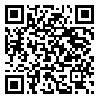Download citation:
BibTeX | RIS | EndNote | Medlars | ProCite | Reference Manager | RefWorks
Send citation to:



BibTeX | RIS | EndNote | Medlars | ProCite | Reference Manager | RefWorks
Send citation to:
Habibi H, khodayari shouti S. The Relationship between Information Literacy and Access to Facilities with Attitudes toward E-learning among students of Urmia University of Medical Sciences . Iranian Journal of Medical Education 2015; 15 :1-8
URL: http://ijme.mui.ac.ir/article-1-3558-en.html
URL: http://ijme.mui.ac.ir/article-1-3558-en.html
() MSc, Department of Educational Sciences, Faculty of Education and Psychology, University of Tabriz, Tabriz, Iran. Email: tmu90et@gmail.com , h.habibi@tabrizu.ac.ir
Abstract: (7922 Views)
Introduction: E-learning is considered as one of the most important elements of higher education in the information era. The present study aimed to investigate the relationship between information literacy and access to facilities with attitudes toward e-learning among students of Urmia University of Medical Sciences.
Methods: This descriptive study was performed on 190 senior students of Urmia University of Medical Sciences in 2013. The participants were selected through cluster sampling. The data were collected through two researcher-made questionnaires. One questionnaire measured information literacy, and the other measured attitudes toward e-learning. Data were analyzed using Pearson correlation coefficient and independent t-test.
Results: The findings showed a significant correlation between information literacy and attitudes toward e-learning (r=0.38) and there was a significant correlation between knowledge of computer and attitudes toward e-learning (r=0.47). Furthermore students’ access to computers (t=3.89) and internet (t=4. 89) affected their attitudes toward e-learning.
Conclusion: Features such as access to computers and the internet, as well as information literacy are related to students' attitudes toward e-learning. Therefore availability of such facilities and efforts to enhance information literacy, especially for students who newly entered higher education might contribute to positive attitudes toward e-learning and implementation of new educational methods. This also paves the way for designing and moving toward implementation of e-learning system in formal educations at Urmia University of Medical Sciences.
Type of Study: Original research article |
Subject:
E-learning
Received: 2014/12/31 | Accepted: 2015/04/7 | Published: 2015/04/28 | ePublished: 2015/04/28
Received: 2014/12/31 | Accepted: 2015/04/7 | Published: 2015/04/28 | ePublished: 2015/04/28
پرسشنامه مطالعه [DOC 106 KB] (627 Download)
Send email to the article author
| Rights and permissions | |
 |
This work is licensed under a Creative Commons Attribution-NonCommercial 4.0 International License. |




